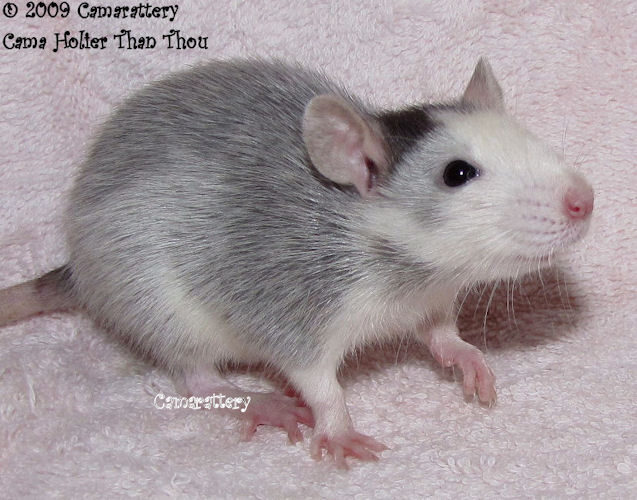Website Updated April.25.2024
We do have babies available!
Please be aware that breeding season only lasts through the end of Spring. Breeding season is over during the Summer as rats loose fertility in hot weather.
Roan Rats

 Roans change color! They are the only color of rat that truly do change. Roans are born solid colored, but from the age of about 4-6 weeks they start to exhibit Roaning. This is a steady increase in the amount of white hairs intermingled with the solid color, starting with the face sides and tail root on the juvenile, then working its way up to the nape of the neck with the molt. With each molt the rat becomes progressively lighter, the final effect not really complete until the rat is well into adulthood, at this time the rat looks more like a solid white rat. This is what is important for adopters to know. Especially if you are adopting a Siamese Roan. As those go all cream at 6 weeks old with no blaze at all. So you will never adopt one for the blaze if its Siamese! Be forewarned.
Roans change color! They are the only color of rat that truly do change. Roans are born solid colored, but from the age of about 4-6 weeks they start to exhibit Roaning. This is a steady increase in the amount of white hairs intermingled with the solid color, starting with the face sides and tail root on the juvenile, then working its way up to the nape of the neck with the molt. With each molt the rat becomes progressively lighter, the final effect not really complete until the rat is well into adulthood, at this time the rat looks more like a solid white rat. This is what is important for adopters to know. Especially if you are adopting a Siamese Roan. As those go all cream at 6 weeks old with no blaze at all. So you will never adopt one for the blaze if its Siamese! Be forewarned.
Roans show up better on darker patterns such as Black, Agouti and Russian Blue although it is possible for them to be any color. The lighter colors seem to fade faster. Better quality Roans fade slower whereas the lesser quality Roans fade more quickly. I've bred mine to Roan slower.
Healthy Roans come in Self, Irish Berkshire and Hooded. The blaze on a Roan is not high white and is safe from megacolon. However, it has been found that if it is bred on a spotted pattern such as variegated or dalmatian for example, megacolon will display. So breeding them to a spotting gene is strongly discouraged since it seems to be lethal. This information is what I gathered from the rat genetics forum from the UK breeders who exported the gene to the U.S.
This gene is recessive, needing two copies of the gene to display. Roan comes from the UK where the name Husky is more commonly used for the variety. The U.S breeders use the term "Roan".
Also, more good reading found at:http://www.nenuphar.plus.com/pendragon/features/husky/index.html
 A Roan after its first moult. They keeping getting lighter with age. The next moult will be lighter still. Of course the more well bred the Roan the darker they stay as they age. Mine never truly get white. Unless it's a white variety like a Siamese.
A Roan after its first moult. They keeping getting lighter with age. The next moult will be lighter still. Of course the more well bred the Roan the darker they stay as they age. Mine never truly get white. Unless it's a white variety like a Siamese.

 Download the Taptalk app on your phone!
Download the Taptalk app on your phone!